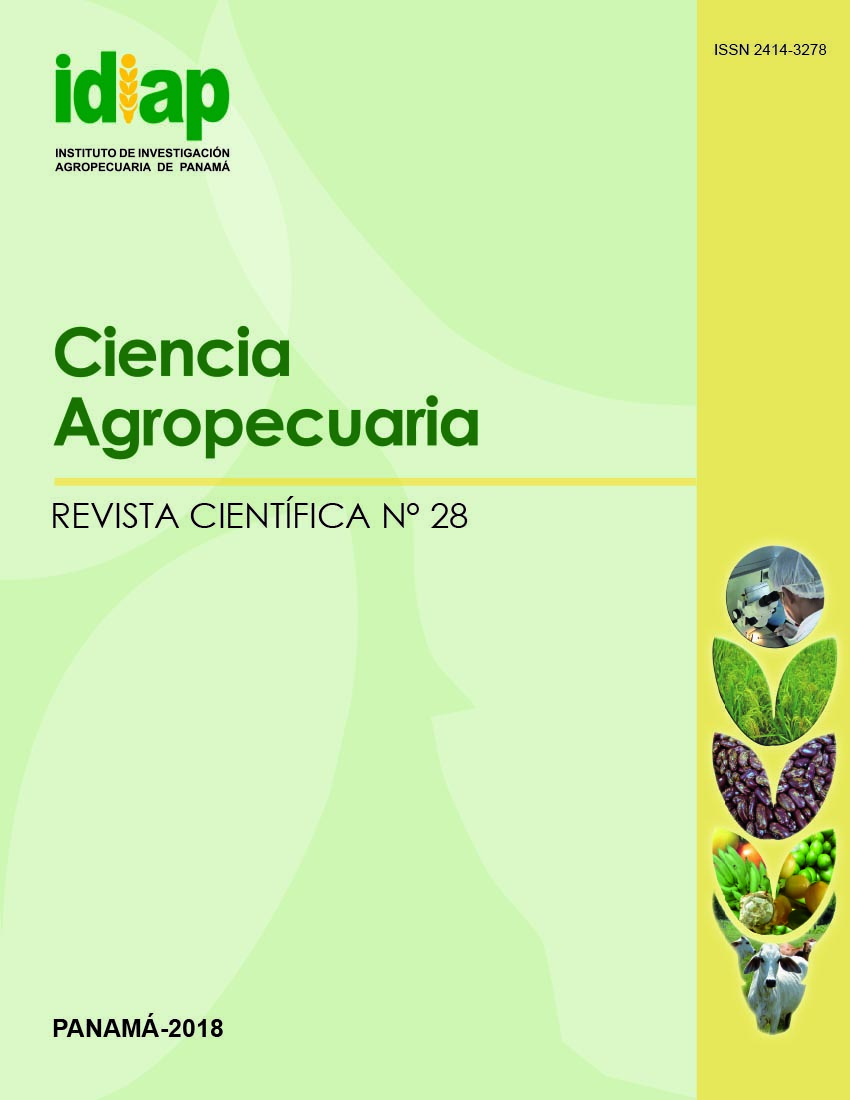ORGANIC TECHNOLOGICAL ALTERNATIVES IN SWEET PEPPER (Capsicum annuum L.) PRODUCTION DURING THE DRY SEASON
Abstract
Conventional management and organic alternatives were evaluated to contribute with the sweet pepper production system, in 500 m2 for each management in El Ejido Experimental Station, between the months of November 2013 and April 2014 in Los Santos province. The organic fertilization based on 5,0 t.ha-1 of earthworm humus and the management of insect pests with vegetable extracts of Azadirachta indica and Gliricidia sepium were included as organic alternatives. The dependent variables were percentage of plant mortality at 15 and 30 days after transplanting, number of damaged fruits per plant, chemical characteristics of the soil and yield in kilograms per hectare. In addition, an analysis of the marginal rate of return was carried out, considering the market price of the fruit from a conventional management and with organic alternatives. The percentage of plant mortality in both treatments was 3%. With organic management, the pH and calcium content were positively improved. In the kilograms per hectare the analysis presented a highly significant difference (P <0,0011), in the conventional management reached 19277,6 kg.ha-1, 4331,7 kg more than with organic alternatives (14945,9 kg.ha-1). The mortality of plants caused by soil pathogens and damaged fruits per plant, were not determining factors in the yield in kilograms per hectare. The complete basic fertilization in conventional management significantly influenced the kilograms per hectare. Without considering the harmlessness of the fruit, but the difference in price due to the incorporation of some organic alternatives, production under this system presented a marginal rate of positive return.
Downloads
References
Aizprúa, JC. 2009. Agroexportadores piden una política agrícola efectiva. La Prensa. Panamá. P. Sept. 55:45 A.
Barahona Amores, LA; Samaniego Sánchez, RD; Guerra Murillo, JA; Castillo, G; Agurto, J. 2015. Utilización de la gallinaza como biofumigante de suelo en el cultivo de melón. Ciencia Agropecuaria no.23:95-109.
Céspedes L, MC. 2005. Agricultura Orgánica. Principios y prácticas de producción (en línea). Instituto de Investigaciones Agropecuarias. Chillán, Chile. Boletín N° 131. Consultado 8 oct. Disponible en biblioteca.inia.cl/medios/biblioteca/boletines/NR33207.pdf
CIMMYT (Centro Internacional de Mejoramiento de Maíz y Trigo, ME) 1988. La formulación de recomendaciones a partir de datos agronómicos: Un manual metodológico de evaluación económica. Edición completamente revisada. México D.F., México: CIMMYT.
Herrera, C. 2010. Extensión Rural (en línea). Consultado 6 oct. 2017. Disponible en http://desarrollorurallasalle.blogspot.com/2010/10/extension-rural.html
Lezcano B, JA. 2005. Estudio preliminar de fuentes y dosis de abonos orgánicos en cebolla (Allium cepa cv. Regia) en Cerro Punta, Bugaba. Ciencia Agropecuaria no.18:113-122.
López-Baltazar, J; Méndez-Matías, A; Pliego-Marín, L; Aragón-Robles, E; Robles-Martínez, ML. 2013. Evaluación agronómica de sustratos en plántulas de chile ‘onza’ (Capsicum annuum) en invernadero (en línea). Revista Mexicana de Ciencias Agrícolas Pub. Esp. (6): p. 1139-1150. Consultado 30 may. 2018. Disponible en http://www.scielo.org.mx/pdf/remexca/v4nspe6/v4spe6a6.pdf
MIDA (Ministerio de Desarrollo Agropecuario, Pa). 2009. Informe cierre 2008-2009. Programa Nacional de Agricultura Orgánica. En prensa.
Rodríguez, H. 2017. Métodos de extensión (en línea). Universidad de Antioquia, Colombia. Consultado 6 oct. 2017. Disponible en aprendeenlinea.udea.edu.co/lms/moodle/file.php/.../3-1-Metodos_de_extension.pdf
Sagastume Estrada, EE. 2015. Evaluación de lombricompost de coqueta roja (Eisenia foetida) en la producción de chile dulce; La Fragua, Zacapa (en línea). Lic. Ing. Agr. Guatemala. Universidad Rafael Landívar. 56 p. Consultado 31 may. 2018. Disponible en recursosbiblio.url.edu.gt/tesiseortiz/2015/06/09/Sagastume-Erick.pdf
Tejera, AE. 2017. Orgánicos con sello panameño. (en línea) La Prensa. Ciudad de Panamá. Pan. Febr. Consultado 2 oct. Disponible en http://impresa.prensa.com/economia/Organicos-sello-panameno_0_4683281658.html
Vásquez P; Céspedes L; Pailán L, H; Vargas, S. 2017. Manejo Orgánico de cultivos hortícolas (en línea). Chile. Consultado 8 oct. 2017. Disponible en www2.inia.cl/medios/biblioteca/boletines/NR38266.pdf
Villarreal, J: Name, B. 1996. Técnicas analíticas del Laboratorio de Suelos. Instituto de Investigación Agropecuaria de Panamá. PA. 110 p.
Esta obra está bajo una licencia de Creative Commons Reconocimiento-NoComercial-CompartirIgual 4.0 Internacional.





